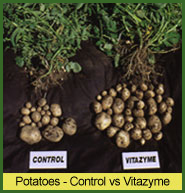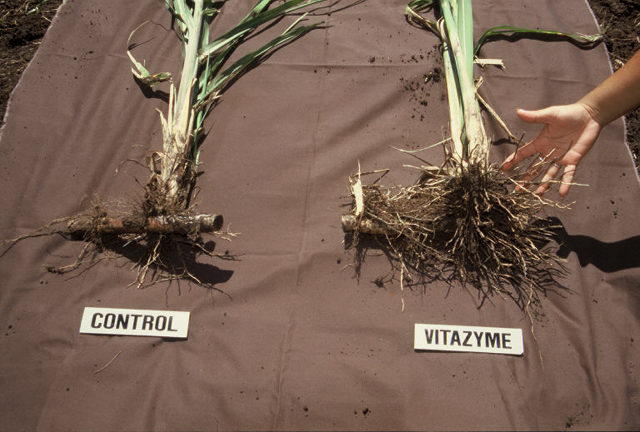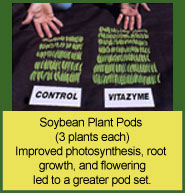
How To Test VitazymeWe encourage everyone to do their own field trials with Vitazyme on their own farms to see first hand the difference by adding Vitazyme to your inputs. Vitazyme is extremely easy to apply. Following instructions in the user guide, one can find recommendations on applications for almost every crop type. If you can't find recommendations in the user guide please contact us and we would be glad to research them for you. The first thing you want to do is select a crop that you would like to test Vitazyme on. We recommend application to the highest dollar value crop you grow. That way you can maximize your increase in yield, to profits. Then become familiar with the applications needed and timing for that crop. Many time these have been developed to coincide with typical spray cycles, so Vitazyme can be tank-mixed with your typical application so as not to incur extra application costs. Once there, you are now ready to set up your trial. It is important to keep the test methodology simple. 1.) It makes it easier to implement. The more difficult the administration of the test, the easier it is not to follow through. 2.) Results don't get masked by mixing the test methodology. Select your test area. It is best to try and select a full acre or hectare for your test, and then make 1/2 of this your control area. Apply your sound agricultural practices as you normally would to the control area. Do the same to the test area except this time add Vitazyme to your mix at the proper application rate. It has been documented in research that Vitazyme use can allow you to reduce your fertilizer input by up to 50% and get the same results. You may test for this if you want, but we would suggest for initial trials, keep it simple and use Vitazyme with your full strength fertilizer input. This will allow you to evaluate the product 'apples to apples.' A few things to keep in mind when applying Vitazyme. It can be applied in any manner including, seed coating, soil drench, irrigation, and foliar spray. Most farm applications are done via spray rigs. When spraying, be aware of wind drift. Results can be hard to find after applications sprayed on windy days. Also be aware of residual spray in your lines, or left over in the tank. Always start the control spraying, then Vitazyme. This will ensure that there is no residual Vitazyme in the tank to mix with your control spray, as minute amounts of Vitazyme can increase your control yield, and mask your results. When you add Vitazyme and mark your control/Vitazyme line, sometimes it can take 10-20 meters of spraying before the Vitazyme mix makes it's way through the lines. In these cases your results will be best well inside the area of your test plot, not at the dividing line between plots. Once your crop starts to mature in its growing cycle, and you have applied Vitazyme per guidelines, it is time to start sampling your plots to look for differences. Make sure you sample plants from well within the boundaries of your control and test plots. This can help mitigate any over-spray or cross-contamination of your areas. Always select groups of representative samples of plants from each area. By this we mean a group of average plants from the areas, not just the biggest or the smallest. The most realistic results are seen when comparing representative samples. Be careful not to damage the plants as you pull them, and try to get all the roots. This is where you will see early development. Now it is time to get to business. It is best to have a piece of black fabric to place plants on side-by-side. You can see it done in some of the research photos on our website, it will help you to see the difference between the plants. Take your sample plants and remove the soil from the root zone. Now you can lay them side-by-side on your fabric. Start your comparisons at the root zone. Look at the root structure, their length and thickness. Look for higher counts of nodules on some plants, and the overall root mass. Next move up the plant, look at shaft development, and leaf development. You will see increased shaft thickness, and better branching structure at times. You should see that leaves increase in count, length and width. Leaves will appear darker, as they produce more chlorophyll, thus fixing more carbon and able to generate more carbohydrates to feed growth. Bud counts will be higher generally, as will flowers. Fruit production will be more consistent in size, and have higher quantity. All plants will not show all of these differences, but most will show some. It is very important to remember that a 5-20% increase in yield at the end of a crop cycle can be a huge amount of increase in income and profit, but that same 5-20% can be very difficult to SEE in the field itself. You must be on the lookout for very subtle differences in the plants, especially when looking at samples from early in the season. We suggest doing this 2-3 times per crop cycle, so you can get a good idea of the added benefits to the plants by using Vitazyme. At season end, keep track of your actual yield. If you have a yield monitor this is easier to do. If not you will need to measure an equal area of each plot, then measure actual volume or weight from the measured area. You can calculate the differences from there. Keep in mind that some crops are priced by grade. If so, you will want to accurately measure the different percentages by grade, as Vitazyme typically produces more uniform sizing, increasing the percentages of higher grades. This can often make a large difference in profit. If you take accurate measurements, we welcome legitimate data, can do statistical analysis, and if appropriate, write a field report based upon the information sent. This is a great marketing tool in other countries for people looking to distribute Vitazyme, as nothing can be a better representative of the product as an accurate report based on your soil and climate conditions, showing yield and profit increases. It will never look like Vitazyme is working if it is haphazardly applied and not followed up with successive applications as recommended. And yield increases will never be known without careful measurement. If you want to throw it on and drive by later to see if it works you will be disappointed. On the contrary, if you take the time to test and evaluate it properly (or just ask for our crop studies since 1996), and agree with us that it works. You are well on your way to increased profits, at very little additional input cost! Order Vitazyme Today - Available in 1 gallon and 2.5 gallon sizes. |
Vitazyme Brochures, User Guide, and Organic Approvals: |
||
Questions/Comments? Email us at comments@plantdesigns.com
Web Design & Development by IC9design.


